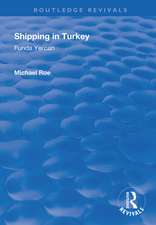Achieving Planned Innovation: A Proven System for Creating Successful New Products and Services
Cu Thomas W. Butler Autor Frank R. Baconen Limba Engleză Paperback – 20 aug 2007
Other topics covered include how to cultivate a lasting market orientation, how to choose selection criteria that reflect strategic objectives and tactical goals, and how to assess the positive and negative influences of external trends on business opportunities. The authors also explain how to creatively exhaust all the 'near-in' opportunities available, from modifying existing products for familiar existing markets and extending their product-life cycles -- with minimal cost, time and risk.
Preț: 96.08 lei
Nou
Puncte Express: 144
Preț estimativ în valută:
18.38€ • 19.25$ • 15.21£
18.38€ • 19.25$ • 15.21£
Carte disponibilă
Livrare economică 17-31 martie
Preluare comenzi: 021 569.72.76
Specificații
ISBN-13: 9781416573210
ISBN-10: 1416573216
Pagini: 176
Dimensiuni: 152 x 229 x 13 mm
Greutate: 0.23 kg
Ediția:98000
Editura: Free Press
Colecția Free Press
ISBN-10: 1416573216
Pagini: 176
Dimensiuni: 152 x 229 x 13 mm
Greutate: 0.23 kg
Ediția:98000
Editura: Free Press
Colecția Free Press
Notă biografică
Frank R. Bacon, Jr., is a professor of marketing at Michigan State University. The originator of the Planned Innovation process, he has assisted many foreign and domestic companies in the development of market-oriented plans and new products for commercial, industrial, military, and aerospace markets. He lives in East Lansing, Michigan.
Cuprins
Contents
Prologue: How Planned Innovation Was Developed and Where It Has Been Used
1. What This Book Is All About
Example 1: What We Mean By a High Rate of Success
Example 2: Achieving Accelerated, Sustained Growth
Example 3: Growth Through Improvements in Existing Products
Example 4: Providing Guidance to R&D
Would Planned Innovation Have Value to Your Firm ?
2. What Is Planned Innovation?
3. The Planned Innovation System
Element One: A Disciplined Scientific Reasoning Process
Element Two: Lasting Marketing Orientation
Element Three: Proper Selection Criteria
Element Four: Using Scientific Reasoning to Determine Requirements Before Making Major Expenditures
Element Five: Ensure Multifunctional Involvement
4. Establishing a Disciplined Scientific Reasoning Process for New Product Innovation
5. The Model of Requirements for Successful Innovation
Model for Identifying Economic and Emotive Value
Four Questions to Address in Each Segment of Focus
Opportunity Selection Criteria Become the Optimizing Function
6. Forming a Lasting Market Orientation
Definition of Business Orientations
Blue Jeans -- a Universal Example
Functional Product-Market Definition
Definition of "Product"
Definition of "Functional Need"
Definition of "Customer"
Definition of "Geography"
Marketing Strategy, Mix, and Plan
Examples of Functional Product-Market Definitions for Blue Jeans
Changing to a Market Orientation
7. The Value of Opportunity Selection Criteria
Selection versus Screening Criteria
Selection Criteria Can Also Be Used for Screening
Issues Involved in Opportunity Selection Process
Importance of Integrating Strategy and Tactics
Matching Resources to Opportunities
Success Must Be Tactical and Strategic
8. Obtaining Proper Inputs to Opportunity Selection Criteria
Mission Statements Guide New Product Innovation
Statement of Financial Goals Needed
The Role of Functional Objectives
Defining Capabilities, Strengths, and Weaknesses
Competitive Opening and Advantage
External Trends
The Mental Work Required Is Well Worth the Effort
9. The Power of Scientific Thought Process in New Product Opportunity Analysis
The Technique of Strong Inferenc
The Benefit of Hypotheses of Cause-Effect
Scientifically Based Opportunity Analysis Can Be Valuable at Any Stage of New Product Development
10. Opportunity Analysis: Initial Assessment Phase
First, Define the Opportunity
Second, Verify that Opportunity Meets Selection Criteria and Establish Priority
Third, Identify Critical Issues
Fourth, Formulate Hypotheses Based on Critical Issues
Fifth, Determine What Information Would Provide the
Most Decisive Test of Hypotheses
Sixth, Go for the Jugular in Obtaining Information
What Should Be Accomplished in the Initial Assessment Phase
11. Opportunity Analysis: Range of Requirements Phase
Testing Hypotheses Regarding Range of Requirements
Sample Size Required
Need for a Carefully Structured Questionnaire
Analysis of Competition
What Should Be Accomplished in the Range of Requirements Phase
12. Opportunity Analysis: Quantitative Confirmation of Market Potential Phase
Design of a Stratified Random Sample
What Should Be Accomplished in the Quantitative Confirmation Phase
13. Application of Opportunity Analysis to Different Types of Products and Markets
Parallel Activities Are Possible
Determining Requirements for Consumer Products
14. Implementing Planned Innovation to Achieve Multifunctional Involvement
Managerial Support Required
Multifunctional Involvement
Qualification and Training of Analysts
Maintaining the Flow of Ideas
Implementing the Planned Innovation System
The Planned Innovation Board
Recurrent Training
Epilogue: How Planned Innovation Provides Answers to Popular Myths Regarding New Product Innovation
Nine Areas of Requirements for Successful Innovation
Myth 1: The Better Mousetrap
Myth 2: Another Xerox
Myth 3: The Gift of Genius
Myth 4: The Lotto
Myth 5: All You Have to Do Is Ask Your Customer
Myth 6: The Alchemist Stone
Notes
Extras
Chapter 1
What This Book Is All About
The message of this book is simple: High rates of success in message new product innovation are possible for any firm, of any size, in any country in the world. Planned innovation is a proven, action-oriented, results-producing recipe for achieving such success. The purpose of this book is to explain the philosophy and procedures which lead to that success.
Do any of the following four scenarios fit your firm's situation?
1. Your firm already has a new product development process which is not functioning smoothly and efficiently, and/or is not producing a high rate of success.
2. Your firm has recently decided it needs accelerated sustained growth through new product developments (possibly because the benefits from a reengineering or cost reduction program have been exhausted, leaving a need for increased profit from accelerated growth).
3. Your firm has concluded that, despite its suitable position in existing product-markets, it needs to modify and extend its current products to maintain or expand its future position in these markets.
4. Your firm has a central or regional R & D group which is operating with little or no input regarding future product-markets.
If you answered yes to any of the four questions, you should read on. The examples given will illustrate how Planned Innovations addresses each of these situations.
Example #1: What We Mean by a High Rate of Success
A ninety-seven percent (97%) commercial success rate is the conclusion from a recent study of the effectiveness of Planned Innovation at The Dow Chemical Company. Amazing, astounding, unbelievable results? Here is a summary of the study's conclusions, in the words of Greg Stevens, former opportunity analyst at Dow, and now president of WinOvations, Inc., of Midland, Michigan.
As part of my independent work, I had occasion to carefully quantify the returns to The Dow Chemical Company over a ten-year period from implementing the Planned Innovation procedures which you have developed. This is the only time such a quantification has been done. It required a great deal of effort, because so many projects were done (277) by so many individuals (73) over such a long time period, both in North America and Europe. Ultimately, I was able to quantify virtually the entire sample.
Key findings from this analysis follow:
1. Ninety-seven percent (97%) of the positive recommendations which the businesses developed made money (33 of 34 projects developed). These results show that it is possible to determine with near certainty which opportunities to develop, even when commercializing substantially new products.
2. The cumulative profits earned (as measured by return on sales) using the Planned Innovation process have exceeded $200 million over a ten-year period, and are rapidly climbing, as many of the ideas being developed are just now entering their commercial stages.
3. In addition to a 97% commercial success rate, virtually all (95%) of the positive projects developed by the businesses moved The Dow Chemical Company in the strategic directions desired by top management.
4. It is clear from the above analysis that it is possible to virtually eliminate major mistakes in new product development, while simultaneously developing substantial numbers of commercially profitable new products that fit the company's strategy. The projects identified as winners virtually all won.
This exceptional result at Dow is, of course, not a result only of Planned Innovation. The Dow Chemical Company is an excellent firm in every respect -- management, personnel, and facilities. Planned Innovation was especially helpful in providing improved guidance and direction at the "fuzzy" front end of an existing development and commercialization process, including determining total product requirements early in the process. This example illustrates that Planned Innovation can help even sophisticated firms with existing new product development processes.
Example #2: Achieving Accelerated, Sustained Growth
Our objective from the beginning has been to develop a philosophy and process that will produce continuous successes, year in and year out, without the high cost of major failures. The net result of such a process is to produce steady growth in sales and profits through new product innovation.
The Donnelly Corporation, a medium-size firm headquartered in Holland, Michigan, is an international supplier of high-quality parts and component systems, mainly rear view mirrors, window systems, interior lighting, and trim systems. The Donnelly management was one of the earliest to embrace the Planned Innovation philosophy. The steady growth achieved by the firm over the 1985-95 decade, shown in Figure 1, was directly related to the use of Planned Innovation procedures.
Rich Cook (who is now president of Cascade Engineering in Grand Rapids, Michigan) was formerly involved with much of this new product development activity at Donnelly.
As a young physicist working for Donnelly, learning this approach to marketing and product creation was a life-transforming experience. This training enabled me, working with the other team members at Donnelly, to create the first glass moonroof/sunroof for Ford Motor Company and the "opera lite," a small decorative window for the Mark and Lincoln Continental. The profitability of the glass moonroof prevented significant job loss at Donnelly during the first oil shock. The opera lite decorative window turned out to be the immediate precursor of the automotive modular window.
Using the principles of Planned Innovation, many significant and innovative products were rapidly created over a decade. These included: (1) coated glass for LCD displays used in consumer electronics such as computers, watches, gas pumps, and clocks; (2) most of the computer touch panels used in the U.S.; (3) the new lighted rear view mirror used in cars, leading to totally new interior lighting in cars, enhancing the safety, comfort, and convenience of all occupants; and, finally, (4) the new large-area, electrochromic mirror for heavy-duty trucks, which will improve long-haul trucking considerably.
In summary, the experience with Planned Innovation has affected the company over the past 20 years in a very positive manner, with the immediate or derivative products creating well over half of all the good-paying jobs at Donnelly today, the vast majority remaining in Western Michigan.</<BR>
Example #3: Growth Through Improvements in Existing Products
Anyone who has witnessed recent Olympics gymnastics events or has watched them on television has seen the tangible benefits of Planned Innovation in action. Over the past twenty years, virtually every item of gymnastics equipment used there, from floor mats to high bars, was redesigned and improved by American Athletic, Inc. (AAI), of Jefferson, Iowa, using Planned Innovation principles. The net result is explained by Bill W. Sorenson, former president of AAI and now chairman of the parent company, American Sports Products Group, Inc., of White Plains, New York:
American Athletic has made many significant engineering, design, material, and performance improvements in their gymnastics equipment over the past 20 years in a sport that for a long time was dominated by Eastern European countries. By following the principles of your Planned Innovation program, they became the world leader in new product innovations and the most respected international manufacturer of equipment for the sport of gymnastics.
It is significant that the world-governing body for gymnastics, the Federal Internationale de Gymnastique (FIG), quickly adopted these innovations into their official apparatus technical specifications, and the higher level of performance provided to U.S. gymnasts by American's technically superior apparatus played a significant part in lifting U.S. gymnasts and gymnastics to world prominence.
All of the equipment innovations and new products and designs added value to American's products. It not only enabled the company to dominate its domestic market, but also to penetrate major overseas markets that would not have opened to them without superior equipment.
But the acid test is always profitability. As a direct result of its successful product development and marketing programs, American's gross profits on its gymnastics equipment increased more than 25%. This is a very significant profit improvement in a mature market like gymnastics.
Seeking ways to grow a stagnant small business unit, Planned Innovation procedures led to dramatic growth in sales and profits by replacing every existing product item in the gym with a better product. This was made possible by more objective, in-depth understanding of unmet customer needs, provided by our procedures.
In seeking to renew the growth and profitability of any business, we always start with reexamination of what might be done to address unmet needs in existing product-markets through modifications and extensions of existing products. Very often, this approach is the least expensive, fastest, and lowest-risk alternative to increased sales and profits. Planned Innovation procedures are especially suited to address such situations, because our approach is designed to achieve a depth of understanding that goes beyond the customers' understanding of their own unmet needs.
Example #4: Providing Guidance to R & D
Often central research units of large firms such as AMF or Dow Chemical, and in smaller companies as well, are essentially left on their own to decide which research projects would be in the best interest of the company. This usually results in a "technology-push" approach, where new technology is generated and then set off "looking for a home," which unfortunately is often not found.
Alternatively, central R & D groups are often asked to develop new products, without clear specifications of requirements, which often results in products which don't meet requirements when introduced to the market.
Both approaches have inefficiencies built in, because the proper level of market-based input is not provided to the researchers. And both approaches often frustrate researchers, who inherently want to contribute to successful outcomes.
We found that this critical communications gap could be effectively bridged in both of these firms, and in others as well, by cross-training a select few scientists and engineers as opportunity analysts, as part of a total Planned Innovation program. Dr. Clive P. Bosnyak, senior associate scientist at Dow, describes the result.
The task was to identify value growth areas for high performance polymers so that research management could more effectively focus resources or, more likely, so they thought, find a home for all the technology we had on hand. Three months later, I had made little progress, but then came Planned Innovation.
My first impression of Planned Innovation was the clear logic that was brought to the marketing and new product development process. Before then, the successful market or new product manager appeared to me to be a magician highly skilled in a mysterious art with secrets impervious to scientists and engineers.
The ability for a scientist or engineer to be able to ask and understand questions related to the determination of business value creates strong links to the business people. In many industrial companies, there are increasing efforts to bridge the technical and business communities, and those people having Planned Innovation training have a strong competitive advantage in their career progressions. For engineers and scientists, the proper identification of market need focuses their programs; for marketing people, the tools dispel technical myths and fantasies. Perhaps, those people with Planned Innovation training appear to be the marketing magicians!
Would Planned Innovation Have Value to Your Firm?
Reflect for a moment on what the above four examples might suggest for your own firm. First, what would be the value of a ninety-plus percent success rate in new products, without the high costs of major failures? Think beyond the financial rewards to the synergistic effect on the firm's total productivity, resulting from the improved morale and heightened confidence an organization experiences from achieving success after success, with the necessary knowledge of a system to allow it to continue to do so.
Even if your firm has a functioning new product development process, how might surer guidance through the first two or three front-end steps dramatically improve the success of the total process? Our experience to date has been that the front end remains a weakness in the product development systems of practically every firm, and almost always can be improved with the Planned Innovation procedures.
Second, what value would your firm derive from a new product development process that essentially guarantees sustained growth through new products, year in and out, again without suffering the high costs of major failures?
Third, consider the value of creatively exhausting all the "near-in" opportunities available from modifying existing products for familiar existing markets, and extending their product life cycles -- all accomplished with minimal cost, time, and risk.
Fourth, consider the value of the future efforts of your R & D personnel which have been wasted in the past because of lack of clear market guidance.
If you conclude that the Planned Innovation system might be of considerable value to your firm, read on to learn what it is and how it is done.
Copyright © 1973, 1981, 1998 by Frank R. Bacon, Jr. and Thomas W. Butler, Jr.
What This Book Is All About
The message of this book is simple: High rates of success in message new product innovation are possible for any firm, of any size, in any country in the world. Planned innovation is a proven, action-oriented, results-producing recipe for achieving such success. The purpose of this book is to explain the philosophy and procedures which lead to that success.
Do any of the following four scenarios fit your firm's situation?
1. Your firm already has a new product development process which is not functioning smoothly and efficiently, and/or is not producing a high rate of success.
2. Your firm has recently decided it needs accelerated sustained growth through new product developments (possibly because the benefits from a reengineering or cost reduction program have been exhausted, leaving a need for increased profit from accelerated growth).
3. Your firm has concluded that, despite its suitable position in existing product-markets, it needs to modify and extend its current products to maintain or expand its future position in these markets.
4. Your firm has a central or regional R & D group which is operating with little or no input regarding future product-markets.
If you answered yes to any of the four questions, you should read on. The examples given will illustrate how Planned Innovations addresses each of these situations.
Example #1: What We Mean by a High Rate of Success
A ninety-seven percent (97%) commercial success rate is the conclusion from a recent study of the effectiveness of Planned Innovation at The Dow Chemical Company. Amazing, astounding, unbelievable results? Here is a summary of the study's conclusions, in the words of Greg Stevens, former opportunity analyst at Dow, and now president of WinOvations, Inc., of Midland, Michigan.
As part of my independent work, I had occasion to carefully quantify the returns to The Dow Chemical Company over a ten-year period from implementing the Planned Innovation procedures which you have developed. This is the only time such a quantification has been done. It required a great deal of effort, because so many projects were done (277) by so many individuals (73) over such a long time period, both in North America and Europe. Ultimately, I was able to quantify virtually the entire sample.
Key findings from this analysis follow:
1. Ninety-seven percent (97%) of the positive recommendations which the businesses developed made money (33 of 34 projects developed). These results show that it is possible to determine with near certainty which opportunities to develop, even when commercializing substantially new products.
2. The cumulative profits earned (as measured by return on sales) using the Planned Innovation process have exceeded $200 million over a ten-year period, and are rapidly climbing, as many of the ideas being developed are just now entering their commercial stages.
3. In addition to a 97% commercial success rate, virtually all (95%) of the positive projects developed by the businesses moved The Dow Chemical Company in the strategic directions desired by top management.
4. It is clear from the above analysis that it is possible to virtually eliminate major mistakes in new product development, while simultaneously developing substantial numbers of commercially profitable new products that fit the company's strategy. The projects identified as winners virtually all won.
This exceptional result at Dow is, of course, not a result only of Planned Innovation. The Dow Chemical Company is an excellent firm in every respect -- management, personnel, and facilities. Planned Innovation was especially helpful in providing improved guidance and direction at the "fuzzy" front end of an existing development and commercialization process, including determining total product requirements early in the process. This example illustrates that Planned Innovation can help even sophisticated firms with existing new product development processes.
Example #2: Achieving Accelerated, Sustained Growth
Our objective from the beginning has been to develop a philosophy and process that will produce continuous successes, year in and year out, without the high cost of major failures. The net result of such a process is to produce steady growth in sales and profits through new product innovation.
The Donnelly Corporation, a medium-size firm headquartered in Holland, Michigan, is an international supplier of high-quality parts and component systems, mainly rear view mirrors, window systems, interior lighting, and trim systems. The Donnelly management was one of the earliest to embrace the Planned Innovation philosophy. The steady growth achieved by the firm over the 1985-95 decade, shown in Figure 1, was directly related to the use of Planned Innovation procedures.
Rich Cook (who is now president of Cascade Engineering in Grand Rapids, Michigan) was formerly involved with much of this new product development activity at Donnelly.
As a young physicist working for Donnelly, learning this approach to marketing and product creation was a life-transforming experience. This training enabled me, working with the other team members at Donnelly, to create the first glass moonroof/sunroof for Ford Motor Company and the "opera lite," a small decorative window for the Mark and Lincoln Continental. The profitability of the glass moonroof prevented significant job loss at Donnelly during the first oil shock. The opera lite decorative window turned out to be the immediate precursor of the automotive modular window.
Using the principles of Planned Innovation, many significant and innovative products were rapidly created over a decade. These included: (1) coated glass for LCD displays used in consumer electronics such as computers, watches, gas pumps, and clocks; (2) most of the computer touch panels used in the U.S.; (3) the new lighted rear view mirror used in cars, leading to totally new interior lighting in cars, enhancing the safety, comfort, and convenience of all occupants; and, finally, (4) the new large-area, electrochromic mirror for heavy-duty trucks, which will improve long-haul trucking considerably.
In summary, the experience with Planned Innovation has affected the company over the past 20 years in a very positive manner, with the immediate or derivative products creating well over half of all the good-paying jobs at Donnelly today, the vast majority remaining in Western Michigan.</<BR>
Example #3: Growth Through Improvements in Existing Products
Anyone who has witnessed recent Olympics gymnastics events or has watched them on television has seen the tangible benefits of Planned Innovation in action. Over the past twenty years, virtually every item of gymnastics equipment used there, from floor mats to high bars, was redesigned and improved by American Athletic, Inc. (AAI), of Jefferson, Iowa, using Planned Innovation principles. The net result is explained by Bill W. Sorenson, former president of AAI and now chairman of the parent company, American Sports Products Group, Inc., of White Plains, New York:
American Athletic has made many significant engineering, design, material, and performance improvements in their gymnastics equipment over the past 20 years in a sport that for a long time was dominated by Eastern European countries. By following the principles of your Planned Innovation program, they became the world leader in new product innovations and the most respected international manufacturer of equipment for the sport of gymnastics.
It is significant that the world-governing body for gymnastics, the Federal Internationale de Gymnastique (FIG), quickly adopted these innovations into their official apparatus technical specifications, and the higher level of performance provided to U.S. gymnasts by American's technically superior apparatus played a significant part in lifting U.S. gymnasts and gymnastics to world prominence.
All of the equipment innovations and new products and designs added value to American's products. It not only enabled the company to dominate its domestic market, but also to penetrate major overseas markets that would not have opened to them without superior equipment.
But the acid test is always profitability. As a direct result of its successful product development and marketing programs, American's gross profits on its gymnastics equipment increased more than 25%. This is a very significant profit improvement in a mature market like gymnastics.
Seeking ways to grow a stagnant small business unit, Planned Innovation procedures led to dramatic growth in sales and profits by replacing every existing product item in the gym with a better product. This was made possible by more objective, in-depth understanding of unmet customer needs, provided by our procedures.
In seeking to renew the growth and profitability of any business, we always start with reexamination of what might be done to address unmet needs in existing product-markets through modifications and extensions of existing products. Very often, this approach is the least expensive, fastest, and lowest-risk alternative to increased sales and profits. Planned Innovation procedures are especially suited to address such situations, because our approach is designed to achieve a depth of understanding that goes beyond the customers' understanding of their own unmet needs.
Example #4: Providing Guidance to R & D
Often central research units of large firms such as AMF or Dow Chemical, and in smaller companies as well, are essentially left on their own to decide which research projects would be in the best interest of the company. This usually results in a "technology-push" approach, where new technology is generated and then set off "looking for a home," which unfortunately is often not found.
Alternatively, central R & D groups are often asked to develop new products, without clear specifications of requirements, which often results in products which don't meet requirements when introduced to the market.
Both approaches have inefficiencies built in, because the proper level of market-based input is not provided to the researchers. And both approaches often frustrate researchers, who inherently want to contribute to successful outcomes.
We found that this critical communications gap could be effectively bridged in both of these firms, and in others as well, by cross-training a select few scientists and engineers as opportunity analysts, as part of a total Planned Innovation program. Dr. Clive P. Bosnyak, senior associate scientist at Dow, describes the result.
The task was to identify value growth areas for high performance polymers so that research management could more effectively focus resources or, more likely, so they thought, find a home for all the technology we had on hand. Three months later, I had made little progress, but then came Planned Innovation.
My first impression of Planned Innovation was the clear logic that was brought to the marketing and new product development process. Before then, the successful market or new product manager appeared to me to be a magician highly skilled in a mysterious art with secrets impervious to scientists and engineers.
The ability for a scientist or engineer to be able to ask and understand questions related to the determination of business value creates strong links to the business people. In many industrial companies, there are increasing efforts to bridge the technical and business communities, and those people having Planned Innovation training have a strong competitive advantage in their career progressions. For engineers and scientists, the proper identification of market need focuses their programs; for marketing people, the tools dispel technical myths and fantasies. Perhaps, those people with Planned Innovation training appear to be the marketing magicians!
Would Planned Innovation Have Value to Your Firm?
Reflect for a moment on what the above four examples might suggest for your own firm. First, what would be the value of a ninety-plus percent success rate in new products, without the high costs of major failures? Think beyond the financial rewards to the synergistic effect on the firm's total productivity, resulting from the improved morale and heightened confidence an organization experiences from achieving success after success, with the necessary knowledge of a system to allow it to continue to do so.
Even if your firm has a functioning new product development process, how might surer guidance through the first two or three front-end steps dramatically improve the success of the total process? Our experience to date has been that the front end remains a weakness in the product development systems of practically every firm, and almost always can be improved with the Planned Innovation procedures.
Second, what value would your firm derive from a new product development process that essentially guarantees sustained growth through new products, year in and out, again without suffering the high costs of major failures?
Third, consider the value of creatively exhausting all the "near-in" opportunities available from modifying existing products for familiar existing markets, and extending their product life cycles -- all accomplished with minimal cost, time, and risk.
Fourth, consider the value of the future efforts of your R & D personnel which have been wasted in the past because of lack of clear market guidance.
If you conclude that the Planned Innovation system might be of considerable value to your firm, read on to learn what it is and how it is done.
Copyright © 1973, 1981, 1998 by Frank R. Bacon, Jr. and Thomas W. Butler, Jr.
























